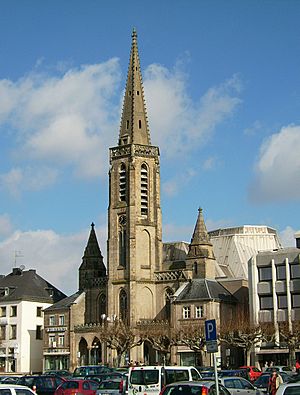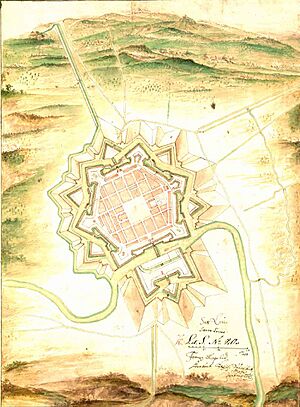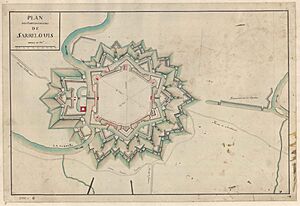Saarlouis facts for kids
Quick facts for kids
Saarlouis
|
|||
|---|---|---|---|

The Ludwigskirche (Saint Louis Church)
|
|||
|
|||
| Country | Germany | ||
| State | Saarland | ||
| District | Saarlouis | ||
| Elevation | 181 m (594 ft) | ||
| Population
(2022-12-31)
|
|||
| • Total | 34,717 | ||
| Time zone | CET/CEST (UTC+1/+2) | ||
| Postal codes |
66740
|
||
| Dialling codes | 06831 | ||
| Vehicle registration | SLS | ||
| Website | www.saarlouis.de | ||
Saarlouis is a town in Saarland, Germany. It is the main town of the Saarlouis district. In 2020, about 34,409 people lived there. Saarlouis is located on the Saar river. It was built as a strong fortress in 1680. The town was named after Louis XIV of France, a French king.
Contents
History of Saarlouis
{{stack|
![]() Kingdom of France 1680–1792
Kingdom of France 1680–1792
![]() French Republic 1792–1804
French Republic 1792–1804
![]() French Empire 1804–1815
French Empire 1804–1815
![]() Kingdom of Prussia 1815–1871
Kingdom of Prussia 1815–1871
![]() German Empire 1871–1918
German Empire 1871–1918
![]() Territory of the Saar Basin 1920–1935
Territory of the Saar Basin 1920–1935
![]() Nazi Germany 1935–1945
Nazi Germany 1935–1945
![]() French occupation zone 1945–1947
French occupation zone 1945–1947
![]() Saar Protectorate (France) 1947–1956
Saar Protectorate (France) 1947–1956
![]() West Germany 1957–1990
West Germany 1957–1990
![]() Germany 1990–present
Germany 1990–present
After some peace treaties in 1678 and 1679, the area of Lorraine became part of France. In 1680, King Louis XIV of France ordered a new fortress to be built. This fortress was meant to protect France's new eastern border. It was built on the banks of the Saar river and was called Sarre-Louis.
The famous French military engineer, Sébastien Le Prestre de Vauban, designed the town. It was planned to be the main city of the new Province de la Sarre. The town's first governor, Thomas de Choisy, made the detailed plans. In 1683, King Louis XIV visited the fortress. He gave the town its coat of arms. This coat of arms shows a rising sun and three Fleur-de-lis (a French symbol). The town's motto is Dissipat Atque Fovet, which means: "He (the Sun) dispels (the clouds) and heats (the earth)."
Changes in Control and Name
In 1697, the Treaty of Ryswick made most of Lorraine independent again. However, Saarlouis and the areas around it stayed French. It was like a small French island surrounded by other lands. During the French Revolution, the town's name was changed to Sarre-Libre. But in 1810, it went back to its original name.
In 1815, after the Treaty of Paris, Saarlouis became part of Prussia. This whole region later became known as the Saargebiet.
Michel Ney's Story
Marshal Michel Ney was born in Saarlouis. He was a very important military leader for Napoleon I. After Napoleon's defeat, Ney was arrested. His lawyer tried to save him by saying Ney was no longer a French citizen because Saarlouis was now Prussian. But Ney said he was French and was later executed.
Saarland's Future
After World War I, French troops took control of Saarlouis. The Saargebiet became a special area managed by the League of Nations for 15 years. In 1933, many Germans who were against the Nazis moved to the Saar. This was because it was the only part of Germany not controlled by the Third Reich.
These anti-Nazi groups wanted the Saarland to stay under League of Nations control. They hoped it would last as long as Adolf Hitler ruled Germany. However, many people in the Saarland still felt strongly German. They did not openly support France.
After 15 years, in 1935, people in the region voted on their future. About 90.3% of them wanted to rejoin Germany. From 1936 to 1945, the Nazis changed the town's name to Saarlautern. They did this to make the name sound more German.
After World War II, France again occupied the region, now called the Saarland. In 1955, most people in the Saarland voted to rejoin West Germany. On January 1, 1957, Saarland became the 10th state of West Germany. In 1980, Saarlouis celebrated its 300th birthday.
Areas of Saarlouis
Over time, several smaller towns and villages have become part of Saarlouis. These include:
- Beaumarais (since 1936)
- Fraulautern (since 1936)
- Lisdorf (since 1936)
- Neuforweiler (since 1970)
- Picard (since 1936)
- Roden (since 1907)
- Steinrausch (since 1972)
Saarlouis Fortifications
The old fortress still shapes the town's unique hexagonal layout. You can still see buildings designed by Vauban. There are also structures from the 1800s when the Prussians controlled the town. After 1887, some parts of the fortress were taken down. But many buildings remain. These include the casemates (underground rooms), some old barracks, and the Great Market. The Great Market has the Commander's Office. You can also see the Vauban island, which was once a small fort. It now has a memorial for Michel Ney.
Economy and Jobs in Saarlouis
Saarlouis was once known for its steel and iron production, and nearby mining. Today, the biggest employer is the Ford Motor Company's Saarlouis Body & Assembly plant. This factory makes the Ford Focus car. The plant opened in 1970.
The industrial port in Saarlouis-Roden is a very busy port. It is Germany's 13th largest inland port. Saarlouis also makes chocolate!
Transport Connections
Saarlouis has a train station on the Saar railway. Trains run every hour to Saarbrücken and Trier. The town is connected to Saarbrücken by the A 620 highway. It is also connected to Luxembourg by the A 8 highway.
Twin Towns – Sister Cities
Saarlouis has special friendships with other towns around the world. These are called "twin towns" or "sister cities."
 Saint-Nazaire, France (since 1969)
Saint-Nazaire, France (since 1969) Eisenhüttenstadt, Germany (since 1986; this was the first time a West German and East German town became twins)
Eisenhüttenstadt, Germany (since 1986; this was the first time a West German and East German town became twins) Matiguás, Nicaragua (since 1986)
Matiguás, Nicaragua (since 1986)
Famous People from Saarlouis
Many notable people were born in Saarlouis:
- Michel Ney (1769–1815), a famous French military leader.
- Heinrich Marx (1777–1838), a lawyer and the father of Karl Marx.
- Martin de Bervanger (1795–1865), a priest.
- Charles-Nicolas Peaucellier (1832–1913), a general and inventor.
- Eduard von Knorr (1840–1920), an admiral in the German Navy.
- Paul Emil von Lettow-Vorbeck (1870–1964), a colonial general and politician.
- Alois Spaniol (1904–1959), a local Nazi Party leader.
- Esther Béjarano (1924–2021), a survivor of the Women's Orchestra of Auschwitz.
- Oskar Lafontaine (born 1943), a politician.
- Rainer Rupp (born 1945), a spy.
- Gabriel Clemens (born 1983), a darts player.
- Ralf Altmeyer (born 1966), a virologist.
- Heiko Maas (born 1966), a politician.
Images for kids
-
The Vauban Island and the memorial of Michel Ney
-
Birthplace of Michel Ney, now a French Restaurant
See also
 In Spanish: Saarlouis para niños
In Spanish: Saarlouis para niños

















